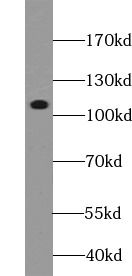Products
HIF1A antibody
| Synonyms: | Hypoxia-inducible factor 1-alpha (HIF-1-alpha antibody, HIF1-alpha)|ARNT-interacting protein|Basic-helix-loop-helix-PAS protein MOP1|Class E basic helix-loop-helix protein 78 (bHLHe78)|Member of PAS protein 1|PAS domain-containing protein 8|HIF1A|BHLHE78|MOP1|PASD8 antibody | ||
| Catalogue No.: | FNab03859 | Reactivity: | Human |
| Host: | Rabbit | Tested Application: | ELISA, IHC, IF, FC, WB |
| Clonality: | polyclonal | Isotype: | IgG |
| Size | Price |
|---|---|
| 100µg | Inquiry |
- SPECIFICATIONS
- FIGURES
- CONDITIONS
- FAQS
- Product Name
- HIF1A antibody
- Catalogue No.
- FNab03859
- Size
- 100μg
- Form
- liquid
- Purification
- Immunogen affinity purified
- Purity
- ≥95% as determined by SDS-PAGE
- Clonality
- polyclonal
- Isotype
- IgG
- Storage
- PBS with 0.02% sodium azide and 50% glycerol pH 7.3, -20℃ for 12 months(Avoid repeated freeze / thaw cycles.)
- Immunogen
- hypoxia inducible factor 1, alpha subunit(basic helix-loop-helix transcription factor)
- Alternative Names
- Hypoxia-inducible factor 1-alpha (HIF-1-alpha antibody, HIF1-alpha)|ARNT-interacting protein|Basic-helix-loop-helix-PAS protein MOP1|Class E basic helix-loop-helix protein 78 (bHLHe78)|Member of PAS protein 1|PAS domain-containing protein 8|HIF1A|BHLHE78|MOP1|PASD8 antibody
- UniProt ID
- Q16665
- Observed MW
- 120 kDa
- Tested Applications
- ELISA, IHC, IF, FC, WB
- Recommended dilution
- WB: 1:200-1:1000; IHC: 1:50-1:200; IF: 1:10-1:100
 mouse small intestine tissue were subjected to SDS PAGE followed by western blot with FNab03859(HIF1a Antibody) at dilution of 1:300
mouse small intestine tissue were subjected to SDS PAGE followed by western blot with FNab03859(HIF1a Antibody) at dilution of 1:300
 Immunohistochemistry of paraffin-embedded human thyroid cancer using FNab03859(HIF1A antibody) at dilution of 1:100
Immunohistochemistry of paraffin-embedded human thyroid cancer using FNab03859(HIF1A antibody) at dilution of 1:100
 Immunofluorescent analysis of Hela cells, using HIF1A antibody FNab03859 at 1:25 dilution and Rhodamine-labeled goat anti-rabbit IgG (red).
Immunofluorescent analysis of Hela cells, using HIF1A antibody FNab03859 at 1:25 dilution and Rhodamine-labeled goat anti-rabbit IgG (red).
- Background
- Functions as a master transcriptional regulator of the adaptive response to hypoxia. Under hypoxic conditions, activates the transcription of over 40 genes, including erythropoietin, glucose transporters, glycolytic enzymes, vascular endothelial growth factor, HILPDA, and other genes whose protein products increase oxygen delivery or facilitate metabolic adaptation to hypoxia. Plays an essential role in embryonic vascularization, tumor angiogenesis and pathophysiology of ischemic disease. Binds to core DNA sequence 5'-[AG]CGTG-3' within the hypoxia response element(HRE) of target gene promoters. Activation requires recruitment of transcriptional coactivators such as CREBPB and EP300. Activity is enhanced by interaction with both, NCOA1 or NCOA2. Interaction with redox regulatory protein APEX seems to activate CTAD and potentiates activation by NCOA1 and CREBBP. Involved in the axonal distribution and transport of mitochondria in neurons during hypoxia.
How many times can antibodies be recycled?
First, usually it's not suggested to recycle antibodies. After use, buffer system of antibodies has changed. The storage condition of recycled antibodies for different customers also varies. Thus, the performance efficiency of recycled antibodies can’t be guaranteed. Besides, FineTest ever conducted the antibody recycling assay. Assay results show recycling times of different antibodies also varies. Usually, higher antibody titer allows more repeated use. Customers can determine based on experimental requirements.
Notes: After incubation, we recycle rest antibodies to centrifuge tube and store at 4℃. High titer antibodies can be stored for a minimum of one week. Reuse about three times.
What are components of FineTest antibody buffer?
Components of FineTest antibody buffer are usually PBS with proclin300 or sodium azide, BSA, 50% glycerol. Common preservative is proclin300 or sodium azide, which is widely applied in the lab and industry.
How about the storage temperature and duration of FineTest antibodies?
Most antibodies are stored at -20℃. Directly-labeled flow cytometry antibodies should be stored at 2 - 8℃. The shelf life is one year. If after sales issues for purchased antibodies appear, return or replacement is available. Usually, antibodies can be still used after the one-year warranty. We can offer technical support services.
Is dilution required for FineTest antibodies? What’s the dilute solution?
Directly-labeled flow cytometry antibodies are ready-to-use without dilution. Other antibodies are usually concentrated. Follow the dilution ratio suggested in the manual. Dilute solution for different experiments also varies. Common antibody dilution buffers are acceptable(e.g. PBST, TBST, antibody blocking buffer).
How to retrieve antibodies for immunohistochemistry?
Common retrieval buffers: Tris-EDTA Buffer(pH 9.0); Citrate Buffer(pH 6.0)
Heat induced antibody retrieval:
Method 1: Water-bath heating: Put the beaker with retrieval buffer and slide in the boiling water bath. Keep the boiling state for 15min. Naturally cool to room temperature;
Method 2: Microwave retrieval: Put the beaker with retrieval buffer and slide in the microwave oven. Heat at high power for 5min, Switch OFF for 3min, Heat at medium power for 5min. Naturally cool to room temperature.
How to choose secondary antibodies?
(1) Secondary antibodies react with primary antibodies. Thus, secondary antibodies should be against host species of primary antibodies. E.g. If the primary antibody is derived from rabbit, the relevant secondary antibody should be against rabbit. E.g. goat anti rabbit or donkey anti rabbit.
(2) Choose secondary antibody conjugates according to the experimental type, e.g. ELISA, WB, IHC etc. Common enzyme conjugated secondary antibodies are labelled by HRP, AP etc. Fluorescin or dye labelled secondary antibodies are applied in immunofluorescence and flow cytometry(e.g. FITC, Cy3).
